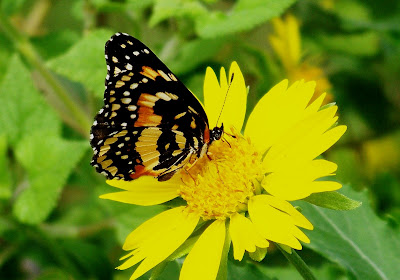
People are mulling around looking for plants to buy at the Lady Bird Johnson Wildflower Center on Saturday.

In the front falling over the wall is Gregg dalea
(Dalea greggii), to the right and not blooming is Gregg salvia
(Salvia greggii), the rosettes on the ground are big red sage
(Saliva penstemonoides), the misty like grass behind the Gregg dalea is gulf coast muhly
(Muhlenbergia capillaris) and behind that is Lindheimer muhly
(Muhlenbergia lindheimeri).
This is a plant that should be listed on the Endangered Species List called Texabama croton
(Croton alabamensis var.
texensis). It was not discovered until 1989, similar to a variety in Alabama and Tennessee. The botanist I talked to thinks the Texas variety is a new species, not just a variety. The Texas variety has a silvery underside to its leaves and it can come back from being burned to the ground, something the ones in Alabama and Tennessee can't do.
This weekend I went to the annual fall plant sale at the Lady Bird Johnson Wildflower Center in Austin. It is a great native plant sale. I got several wildflowers (and a grass) that I hope do well in my area, including Lindheimer senna, Copper Canyon daisy, Wright's yellowshow, Antelope horn milkweed, Gregg dalea, tree morning glory, skeleton plant, Missouri primrose, blue shrub sage and switch grass. I was hoping to pick up a madrone, but those were all bought during the members' only sale on Friday. I had a good time walking around the wildflower center, talking to an old Austin friend, Dean. If you ever visit Austin (or live there), the wildflower center has a great variety of trails and plants to enjoy and learn about. Being good stewards for nature means we all should fill our gardens up as much as possible with native plants. They are just as beautiful as any plants in the world, but because they are from here, they use fewer resources to keep them thriving, and they are important to the survival of all kinds of wildlife. It would help, however, if we didn't destroy so much of it in the first place. Why can't homebuilders not flatten every square inch. Why does Bermuda grass need to replace little bluestem and prairie flowers or areas of native shrubs and trees?















